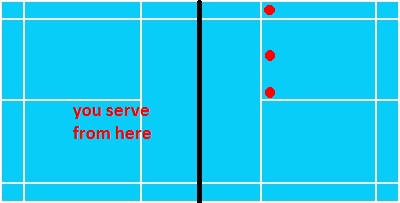How to make good serve to a left handed oponent?
by Newton
(Canberra, Australia)
Question: How to make good serve to a left handed opponent? I am right handed person. How can I do a good serve to a left handed opponent?
Answer:
Hi Newton, thank you for your question.
Firstly, it depends whether you’re playing singles or doubles.
I’ll discuss how you can make a good service from a singles and doubles perspective.
Badminton Serve for Singles
When playing in a singles match today, you have a choice to go for a high serve or a low serve.
The low serve is more commonly used because badminton players are much faster and stronger than before.
A high serve is more likely to give your opponent the chance to commence the first attack (jump smash) in the rally.
- If you go for the high serve, I would recommend hitting the high serve to the singles sidelines at your opponent’s baseline (see picture above).
- If you go for the low serve, it doesn’t really matter where you hit your serve to. As long as you hit your low service with precision (aiming for the shuttle to fly RIGHT ABOVE the net) you’re safe.
Try directing your low serve to your opponent’s backhand area. Generally, most people are better with their forehand than backhand.
Badminton Serve for Doubles
In badminton doubles, I highly suggest you avoid a high serve because:
- For doubles, you can’t serve pass the baseline – thus, making a high serve just before the baseline will give your opponent a clear chance to smash. A smash at that point makes it easy for your opponent to win a rally.
- Your opponent will grab the opportunity to hit a powerful smash. His partner will be there to cover him if you manage to return his smash.
When hitting a low serve in doubles, take your partner into consideration.
Basically you can either serve to the middle of the court, towards your opponent’s body, or towards the sidelines (see picture above).
Once you make the service, your opponent will more likely leap forward to hit a drive, spinning net shot, or even a smash (if your serve is too high)
It’s not a big concern if your opponent is left handed.
All you need to consider is whether you and your partner can defend against the return shot when you serve to those areas.
However the key is of course, to hit the shuttle so that that it passes just slightly above the net.

